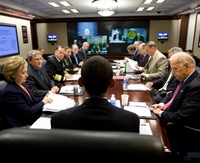Two weeks ago, while discussing last November's tragic events at Fort Hood, Defense Secretary Robert Gates proclaimed that the Pentagon "is burdened by 20th century processes and attitudes mostly rooted in the Cold War." This acknowledgement by a wartime defense secretary is yet another stark reminder that the broader U.S. national security system was also designed for a much different era, and stands in need of a holistic review and systemic modernization.
When the National Security Act of 1947 was enacted, the national and global security environments were exceedingly different from those that exist today. Responding to the costly inefficiencies of how the U.S. structured itself for and waged war, President Harry Truman's bold mid-century reorganization of government was designed to meet the emerging Cold War challenges posed by a single nation-state adversary. The world has changed in complexity and speed since then, yet we continue to rely on much of the same architecture to address the realities of the new security environment.
The realization that our government must substantially adapt in order to protect its citizens and preserve the nation's strength seems to come as a perpetual surprise. Each time our venerable 20th-century institutions are confronted by the inherent challenge of responding to contemporary threats with outmoded concepts and cultures, we frantically seek to answer why the system let us down. Most often, bandages are applied as quick fixes in place of the deeper structural and cultural reforms that are desperately needed to replace greatly antiquated and inadequate mechanisms.

